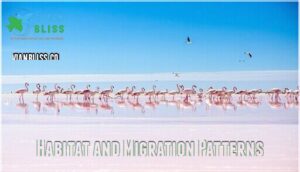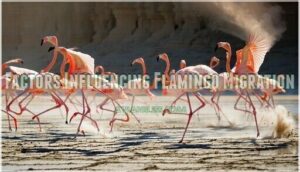This site is supported by our readers. We may earn a commission, at no cost to you, if you purchase through links.
 Flamingos do migrate, but not all of them pack their bags every season.
Flamingos do migrate, but not all of them pack their bags every season.
Their migration depends on food, water, and weather. If their lake dries up or freezes over, they’ll take to the skies in search of better conditions.
These pink travelers can fly hundreds of miles overnight, using strong winds to save energy. Notably, some flamingos stay put if their habitat stays cozy and stable.
They’re social fliers, moving in flocks for safety—because who wants to travel alone? Timing and routes vary by species, but their adaptability is key.
Curious about their flight secrets? Stick around for more fascinating details.
Table Of Contents
- Key Takeaways
- Flamingo Migration
- Habitat and Migration Patterns
- Flamingo Population and Conservation
- Factors Influencing Flamingo Migration
- Timing and Destination of Flamingo Migration
- Frequently Asked Questions (FAQs)
- Where do flamingos go in the winter?
- Do flamingos migrate to Florida?
- Do flamingos hibernate or migrate?
- Are there flamingos in the United States?
- How do flamingos navigate during migration?
- What role does diet play in migration?
- Do flamingos migrate in family groups?
- How do flamingos prepare for migration?
- What challenges do flamingos face during migration?
- Conclusion
Key Takeaways
- Flamingos migrate when food, water, or weather conditions force them to, covering hundreds of miles overnight.
- They’re social fliers, traveling in flocks for safety and energy efficiency, often in V-formations.
- Migration isn’t predictable and depends on environmental triggers like drought, freezing lakes, or habitat loss.
- Not all flamingos migrate; some stay put if their habitat remains stable and provides enough resources.
Flamingo Migration
Flamingos aren’t your typical migratory birds, but they’ll move when their environment demands it.
Whether it’s freezing lakes or food shortages, these graceful flyers adapt by traveling hundreds of miles to survive.
Reasons for Migration
When flamingos take flight, it’s often a matter of survival. Why do flamingos migrate? They’re driven by environmental changes that make their habitats unlivable. Drought effects, habitat loss, and food shortages are major triggers.
Flamingos migrate to escape drought, habitat loss, and food scarcity, showcasing their incredible resilience and adaptability.
Imagine a drying lake or harsh weather forcing these graceful birds to relocate. Flamingos respond quickly, covering up to 600 kilometers overnight to find better conditions. They often migrate in search of flamingo food sources to sustain themselves during their journeys.
- Drought shrinking water sources.
- Harsh weather like freezing winters.
- Unpredictable rainfall altering food availability.
Climate change amplifies these challenges, making flamingo migration more erratic. Their incredible endurance guarantees they reach safer, resource-rich destinations just in time.
Flight Behavior
Imagine this: a graceful flock gliding in V-formation, maximizing energy efficiency.
With wingspans adapted for endurance, flamingos maintain airspeed variations of 40-60 mph.
Their nocturnal flights cover vast distances, often at altitudes up to 15,000 feet.
Group dynamics dictate altitude preference and tight coordination during flamingo migration.
Understanding flamingo flight patterns is essential for conservation efforts.
Check out their flight behavior below:
Flight Feathers and Molting
When it’s time for a feather replacement, flamingos enter a molting cycle, temporarily grounding their flight patterns.
This pause guarantees proper wing maintenance and vibrant plumage care for future journeys.
During molting, you might notice:
- Old feathers shed to make way for new ones.
- Synchronization with flamingo migration patterns.
- Preparation for long flights along flamingo migration paths, including the migration routes of greater flamingo populations.
Flamingos require proper feather care tips to maintain their unique appearance and flying abilities.
Habitat and Migration Patterns
You’ll find flamingos in some of the world’s most extreme habitats, from salty lakes to high-altitude wetlands.
Flamingos thrive in the planet’s harshest landscapes, from shimmering salt flats to breathtaking high-altitude wetlands.
Their migration patterns aren’t as predictable as other birds, often influenced by food, weather, and water conditions.
Preferred Habitat
When tracking flamingo migration patterns, look to saline lakes and alkaline wetlands.
These birds thrive in habitats like mangrove swamps, tidal flats, and sandy islands, often avoiding fish-filled waters.
Greater flamingos roam the Yucatán Peninsula, while Chilean flamingos prefer less crowded breeding grounds.
Their wintering grounds often feature pristine, undisturbed wetlands.
It’s fascinating how these vibrant birds adapt their habitat choices to guarantee survival and safety year-round.
Understanding habitat conservation strategies is vital for protecting these species and their habitats, which is crucial for their year-round survival.
Non-Migratory Adaptations
Not all flamingos take flight for migration.
As nonmigratory birds, they’ve mastered survival by adapting to shifting conditions.
You’ll find them thriving in stable habitats where food is plentiful and disruptions are minimal.
Their feeding strategies and social behavior help them endure environmental changes without relocating.
- Breeding habits align with local conditions.
- Flocking dynamics strengthen survival.
- Nesting patterns adapt to water levels.
- Diet flexibility supports resilience.
- Minimal travel conserves energy.
Flamingo Population and Conservation
You might be surprised to learn that flamingo populations vary widely, with some species numbering in the millions while others are much rarer.
Protecting these iconic birds isn’t just about saving their habitats—it’s also about addressing threats like pollution, predators, and climate change.
Global Population Estimates
From vast wetlands to salty lagoons, flamingos thrive in diverse habitats, yet their global population trends tell a mixed story.
Lesser Flamingos lead in numbers, with 1.5-2.5 million, while Andean Flamingos barely reach 34,000.
Check this snapshot:
These graceful birds‘ migration patterns and population size highlight the delicate balance of their ecosystems.
The global flamingo population trends are influenced by various factors, including habitat availability and climate change.
Threats to Flamingos
Flamingos face serious challenges like habitat loss, pollution effects, and climate change.
Rising seas can drown nests, while human disturbance disrupts their routines.
Food scarcity and oil spills threaten survival, complicating flamingo migration.
Imagine a bird traversing these flamingo migration threats—daunting, right?
Protecting wetlands and reducing human threats guarantees their pink elegance remains a vibrant part of our world.
Conservation Efforts
Protecting flamingos starts with smart conservation efforts.
Habitat protection is key—wetlands must stay safe from development and pollution. You can also support species research to better understand flamingo migration threats and behaviors.
Here are three flamingos conservation ideas to ponder:
- Create protected wetlands to combat habitat loss.
- Involve local communities in wildlife preservation and education.
- Monitor populations to guide environmental policy.
Community engagement guarantees these graceful birds thrive, despite challenges like habitat loss and climate changes.
Effective conservation requires understanding of flamingo conservation methods and strategies.
Factors Influencing Flamingo Migration
You might think flamingos migrate just for fun, but their movements are driven by survival.
Factors like freezing weather, shrinking water levels, and threats from predators or humans often push them to find safer, more livable habitats.
Ice-Cold Weather
When winter temperatures plunge and frozen lakes take over, flamingos face food scarcity and icy challenges.
Can flamingos survive cold weather? They don’t hibernate, but their cold tolerance only goes so far.
In freezing temperatures, they huddle together, sharing warmth like nature’s feathered heaters.
Fat reserves help fuel winter survival, but flamingo freezing temperatures often trigger migration.
Ice-cold weather pushes them to seek milder regions, proving why flamingo migration beats braving bitter winds.
Changing Water Levels
When water levels rise or drought impacts habitats, flamingos adapt by relocating to new wetlands.
These water level fluctuations and salinity changes disrupt feeding strategies and breeding success.
Flooding effects can make wading impossible, while drought shrinks food sources.
Migration patterns shift as flamingos seek better conditions, proving their resilience in the face of habitat disruption and environmental challenges.
This ability to migrate is influenced by their unique flight speed capabilities, allowing them to cover long distances in search of suitable habitats, showcasing their adaptation to changing environments and environmental challenges.
Human Interference and Predators
Habitat destruction and human disturbance push flamingos from their homes, while predators like eagles claim about 1% of the population yearly.
Coastal development, pollution effects, and ecological imbalance disrupt migration patterns, forcing these birds to seek safer grounds.
Predator control and flamingo conservation migration efforts can help, by addressing environmental impact and protecting key sites, we can reduce human interference and guarantee flamingos thrive in their delicate ecosystems.
Timing and Destination of Flamingo Migration
You might be surprised to learn that flamingos don’t follow rigid migration schedules like some birds.
Instead, their timing and destinations depend on food availability, weather, and the need for safe breeding grounds.
When Do Flamingos Migrate?
Seasonal movements in flamingos are sparked by nature’s cues.
When do flamingos migrate? It’s during the flamingo migration season, triggered by:
- Shrinking waterbodies reducing food supplies.
- Weather influence, like freezing temperatures.
- Breeding seasons, as rainfall creates nesting grounds.
Flock behavior kicks in, and they take flight, proving migration patterns can be as unpredictable as the weather itself!
Migration Routes and Destinations
Flamingo migration routes are as unpredictable as the wind.
These graceful flyers adapt their flight patterns based on food, weather, and safety.
Migration maps reveal diverse destination choices, from tropical coasts to inland lakes.
Stopover sites act as pit stops, offering rest during their journey.
The greater flamingo migration route map highlights their impressive ability to traverse continents.
Flamingo flight paths showcase nature’s ultimate route planning for survival and exploration.
Understanding flamingo migration patterns is essential for conservation efforts.
Frequently Asked Questions (FAQs)
Where do flamingos go in the winter?
You might think flamingos stay put, but in winter, they often head south to warmer spots.
Depending on the species, they’ll travel to regions like Africa, the Caribbean, or southern wetlands, chasing food and comfort.
Do flamingos migrate to Florida?
You won’t typically find flamingos migrating to Florida.
American Flamingos are mostly non-migratory, but they can wander into Florida from the Caribbean when searching for food or breeding grounds, adding a splash of pink charm.
Do flamingos hibernate or migrate?
They don’t hibernate, but they do migrate when conditions get tough.
If food runs low, water freezes, or habitats dry up, flamingos take flight—sometimes traveling hundreds of miles overnight to find better living conditions, which can be a tough decision.
Are there flamingos in the United States?
You’ll find American Flamingos in the United States, mainly in Florida.
Though rare, they sometimes appear in Texas or other Gulf states.
These tall, pink beauties are often spotted in wetlands or coastal areas.
How do flamingos navigate during migration?
Flamingos rely on visual cues, landmarks, and the Earth’s magnetic field to navigate during migration.
They also use wind patterns to conserve energy, flying in V-formations that reduce drag and help them travel efficiently.
What role does diet play in migration?
About 60% of a flamingo’s diet is rich in carotenoids, which color their feathers pink.
When food supplies dwindle, they’ll fly hundreds of miles to find algae or shrimp, proving even flamingos won’t settle for bad takeout!
Do flamingos migrate in family groups?
You’ll often see flamingos migrating in large flocks, but they don’t stick strictly to family groups.
Instead, they form massive colonies, mixing with others for better survival, like a giant pink reunion in the sky!
How do flamingos prepare for migration?
Before taking off, they bulk up on food to store energy, gather in flocks for safety, and wait for favorable winds.
It’s like packing snacks and carpooling for a long road trip!
What challenges do flamingos face during migration?
During migration, they face harsh weather, predators, and food shortages.
Freezing temperatures or droughts can force detours, while strong winds challenge their endurance.
It’s like nature throws every curveball possible to test their resilience!
Conclusion
Flamingos migrating is like nature’s version of a grand road trip—except with wings and a flock.
These unique birds only migrate when they must, driven by food shortages, freezing weather, or shrinking water sources.
Adaptable and social, they’ll stick around if conditions are just right, proving not all flamingos are frequent travelers.
Understanding “do flamingos migrate” helps us appreciate their survival instincts and natural beauty while highlighting the importance of protecting their fragile habitats.







